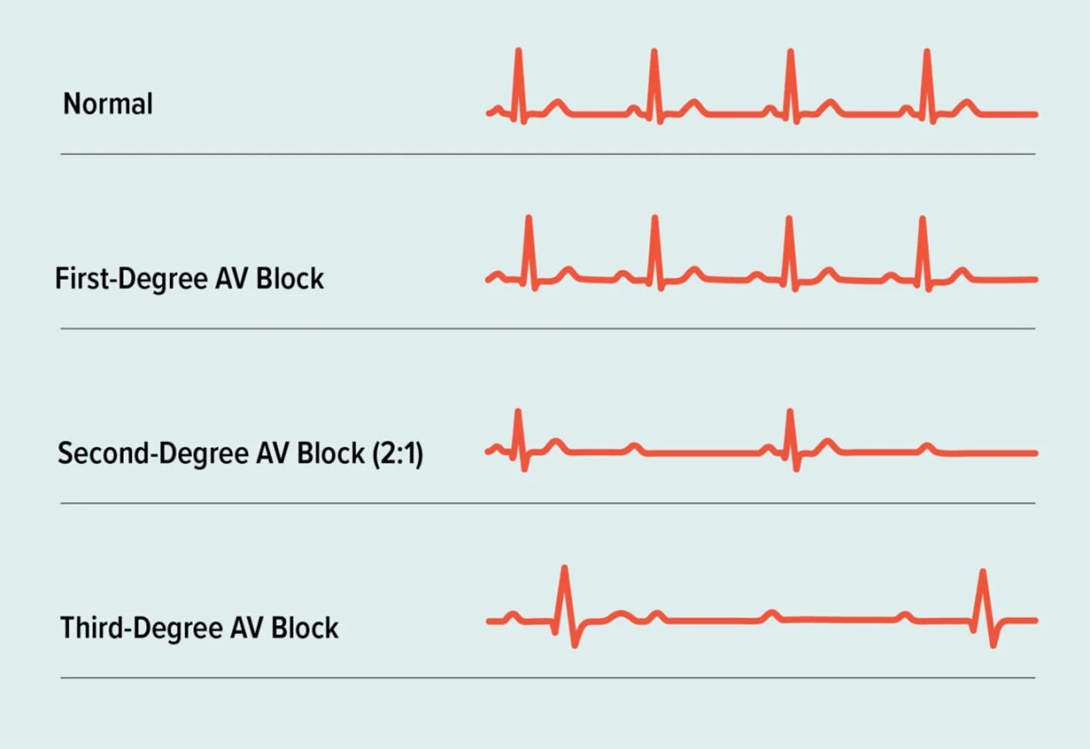A nurse is caring for a client who has been prescribed parenteral lidocaine. Before administering the medication, the nurse should review the medical record for which condition?
Glaucoma.
Heart block.
Gastric ulcers.
Diabetes mellitus.
The Correct Answer is B
Choice A reason: Glaucoma is not directly related to the administration of lidocaine, as it does not affect intraocular pressure or the pathophysiology of glaucoma.
Choice B reason: Heart block is a type of arrhythmia where the electrical signal is delayed or blocked entirely. Since lidocaine affects cardiac conduction, it is crucial to review the medical record for heart block before administration.
Choice C reason: Gastric ulcers are not typically a concern when administering lidocaine, as it does not have gastrointestinal effects when given parenterally.
Choice D reason: Diabetes mellitus is not a contraindication for lidocaine administration; however, monitoring blood glucose levels is always important in diabetic patients receiving any medication.

Nursing Test Bank
Naxlex Comprehensive Predictor Exams
Related Questions
Correct Answer is C
Explanation
Choice A reason: Assessing body temperature is a routine post-procedure check but not the most critical for thrombocytopenia.
Choice B reason: Monitoring skin elasticity is not directly related to the risks associated with thrombocytopenia following a bone marrow biopsy.
Choice C reason: Observing the aspiration site is crucial because thrombocytopenia increases the risk of bleeding, and the site must be monitored for any signs of hemorrhage.
Choice D reason: Measuring urinary output is important but does not take precedence over monitoring the biopsy site for bleeding in a thrombocytopenic patient.
Correct Answer is C
Explanation
The correct answer is: c. Inspiratory and expiratory bilateral crackles.
Choice A: Average urine output of 28 mL/hour
Reason: The normal urine output for an adult is typically 0.5 mL/kg/hr, which translates to about 30-50 mL/hr for most adults. An average urine output of 28 mL/hour is slightly below this range, indicating possible inadequate fluid resuscitation. However, it is not immediately life-threatening and does not warrant the most urgent intervention compared to other options.
Choice B: Vesicular bibasilar breath sounds
Reason: Vesicular breath sounds are normal lung sounds heard over most of the lung fields. They are soft and low-pitched, indicating that the airways are clear. Therefore, vesicular bibasilar breath sounds do not indicate any immediate respiratory distress or fluid overload and do not require urgent intervention.
Choice C: Inspiratory and expiratory bilateral crackles
Reason: Crackles, also known as rales, are abnormal lung sounds that indicate the presence of fluid in the alveoli. Bilateral crackles heard during both inspiration and expiration suggest significant pulmonary edema or acute respiratory distress syndrome (ARDS), which can be life-threatening and requires immediate intervention.
Choice D: Central venous pressure of 12 mm Hg
Reason: The normal range for central venous pressure (CVP) is 2-8 mm Hg. A CVP of 12 mm Hg is elevated, indicating possible fluid overload or heart failure. While this is concerning and requires monitoring, it is not as immediately critical as bilateral crackles, which directly affect oxygenation and respiratory function.
Whether you are a student looking to ace your exams or a practicing nurse seeking to enhance your expertise , our nursing education contents will empower you with the confidence and competence to make a difference in the lives of patients and become a respected leader in the healthcare field.
Visit Naxlex, invest in your future and unlock endless possibilities with our unparalleled nursing education contents today
Report Wrong Answer on the Current Question
Do you disagree with the answer? If yes, what is your expected answer? Explain.
Kindly be descriptive with the issue you are facing.
